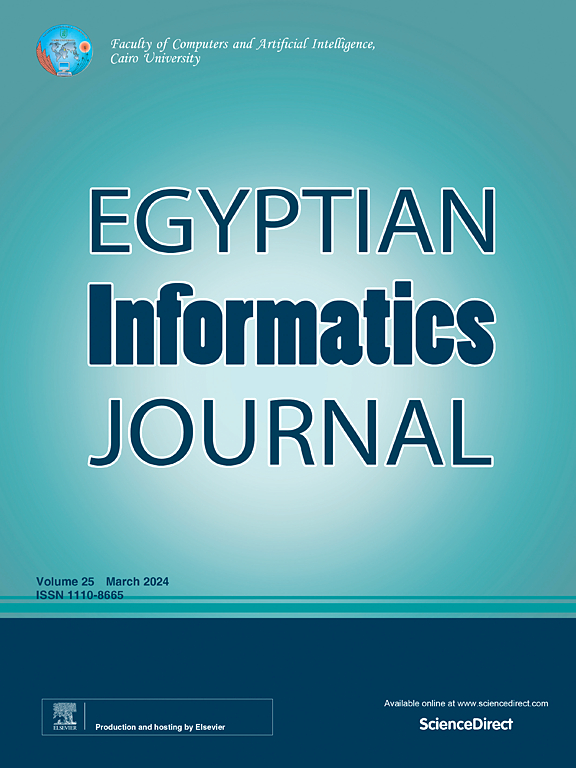Eeg-based detection of epileptic seizures in patients with disabilities using a novel attention-driven deep learning framework with SHAP interpretability
IF 4.3
3区 计算机科学
Q1 COMPUTER SCIENCE, ARTIFICIAL INTELLIGENCE
引用次数: 0
Abstract
Epileptic seizures are neurological events caused by abnormal electrical activity in the brain, frequently resulting in loss of consciousness, involuntary movements, or cognitive deficits. Electroencephalograms (EEGs) are essential for diagnosing epilepsy, but conventional detection techniques depend on manual analysis, which can be labor-intensive and susceptible to inaccuracies. Recent developments in artificial intelligence (AI) and deep learning have facilitated the automation of seizure detection from EEG signals with improved accuracy. Nevertheless, current models frequently face challenges related to feature selection, interpretability, and computational demands. In this research, we introduce a cutting-edge deep learning methodology for the automated prediction of epilepsy, incorporating a Novel Attention Module (NAM) into a new Convolutional Neural Network (CNN) to improve the extraction of features from EEG signals. The proposed system employs Fourier Transform for feature extraction, utilizes Principal Component Analysis (PCA) for reducing dimensionality, and applies an optimized stochastic gradient descent approach with the Adam optimizer to enhance the learning process. We articulate the mathematical characteristics of feature selection driven by NAM, delineate the convergence attributes of the loss function, and present measures of explainability through Shapley Additive Explanations (SHAP). The model underwent training, validation, and testing with three publicly accessible EEG datasets sourced from PhysioNet and ResearchGate, thereby ensuring strong generalization across various datasets. A series of experiments were carried out to assess the effectiveness of the model by utilizing key performance metrics such as accuracy, sensitivity, specificity, and F1-score. The proposed methodology attained an accuracy of 99.3 %, an F1-score of 99.5 %, and both sensitivity and specificity at 99 %, showcasing its superior performance compared to existing models. Additionally, the computational complexity of the proposed framework was evaluated in terms of floating-point operations per second (FLOPs) and the total number of parameters, ensuring its efficiency for real-time biomedical applications. The incorporation of explainability techniques, including Shapley Additive Explanations (SHAP), enhances model transparency, which is beneficial for clinical decision-making. These findings suggest that the proposed attention-enhanced CNN framework serves as a reliable and interpretable tool for the early detection of epilepsy and patient monitoring.
使用具有SHAP可解释性的新颖注意力驱动深度学习框架对残疾患者癫痫发作进行基于eeg的检测
癫痫发作是由大脑异常电活动引起的神经系统事件,通常导致意识丧失、不自主运动或认知缺陷。脑电图(eeg)对于诊断癫痫至关重要,但传统的检测技术依赖于人工分析,这可能是劳动密集型的,而且容易出错。人工智能(AI)和深度学习的最新发展促进了从脑电图信号中自动检测癫痫的准确性。然而,当前的模型经常面临与特征选择、可解释性和计算需求相关的挑战。在这项研究中,我们引入了一种前沿的深度学习方法来自动预测癫痫,将一种新颖的注意力模块(NAM)结合到一种新的卷积神经网络(CNN)中,以改进脑电图信号的特征提取。该系统采用傅里叶变换进行特征提取,利用主成分分析(PCA)进行降维,并采用优化的随机梯度下降方法和Adam优化器来增强学习过程。我们阐明了由NAM驱动的特征选择的数学特征,描述了损失函数的收敛属性,并通过Shapley加性解释(SHAP)提出了可解释性的度量。该模型接受了来自PhysioNet和ResearchGate的三个公开访问的EEG数据集的训练、验证和测试,从而确保了不同数据集的强泛化。通过使用准确性、敏感性、特异性和f1评分等关键性能指标,进行了一系列实验来评估该模型的有效性。该方法的准确率为99.3%,f1评分为99.5%,灵敏度和特异性均为99%,与现有模型相比表现出优越的性能。此外,根据每秒浮点运算次数(FLOPs)和参数总数对所提出框架的计算复杂度进行了评估,以确保其在实时生物医学应用中的效率。可解释性技术的结合,包括Shapley加性解释(SHAP),提高了模型的透明度,这有利于临床决策。这些发现表明,所提出的注意力增强CNN框架可作为早期发现癫痫和患者监测的可靠且可解释的工具。
本文章由计算机程序翻译,如有差异,请以英文原文为准。
求助全文
约1分钟内获得全文
求助全文
来源期刊

Egyptian Informatics Journal
Decision Sciences-Management Science and Operations Research
CiteScore
11.10
自引率
1.90%
发文量
59
审稿时长
110 days
期刊介绍:
The Egyptian Informatics Journal is published by the Faculty of Computers and Artificial Intelligence, Cairo University. This Journal provides a forum for the state-of-the-art research and development in the fields of computing, including computer sciences, information technologies, information systems, operations research and decision support. Innovative and not-previously-published work in subjects covered by the Journal is encouraged to be submitted, whether from academic, research or commercial sources.
 求助内容:
求助内容: 应助结果提醒方式:
应助结果提醒方式:


